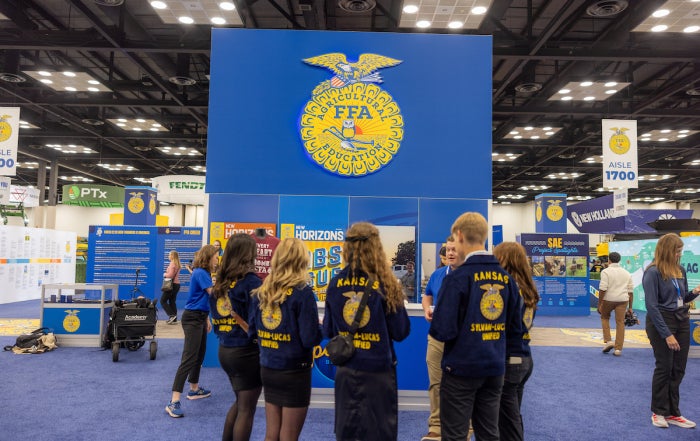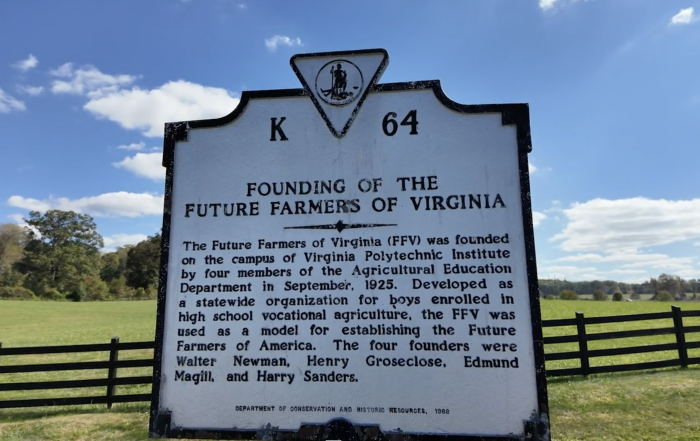
The National FFA Organization is an integral part of agricultural education by helping make classroom instruction come to life through realistic, hands-on applications.
FFA members embrace concepts taught in agricultural science classrooms nationwide, build valuable skills through hands-on experiential learning and each year demonstrate their proficiency in competitions based on real-world agricultural skills.
FFA makes a positive difference in the lives of students by developing their potential for premier leadership, personal growth and career success through agricultural education. FFA membership today is comprised of 850,823 student members in grades 5-12 who belong to one of 8,995 local FFA chapters throughout the United States, Puerto Rico and the U.S. Virgin Islands.
FFA operates on local, state and national levels. Student members belong to chapters organized at the local school level. Agriculture educators serve as chapter advisors. Chapters are organized under state associations headed by an advisor and executive secretary, often employees of the state department of education. States conduct programs and host annual conventions.
The National FFA Organization is governed by a board of directors, charters state associations and provides direction, program materials and support for local chapters and state FFA associations.
FFA was organized nationally in 1928 in Kansas City, Mo. In 1950, Congress granted FFA a federal charter, making it an integral part of public agricultural instruction under the National Vocational Education Act. FFA receives no federal funding.
The U.S. Department of Education provides leadership and helps set direction for FFA as a service to state and local agricultural education programs.
Science, Business, Technology
The National FFA Organization has evolved in response to expanded opportunities available in the industry of agriculture. Today’s FFA helps members prepare for careers in agribusiness, agrimarketing, science, communications, education, horticulture, production, natural resources, forestry and many other diverse fields.
Career Preparation
The agricultural education program provides a well-rounded, practical approach to learning through three components: Classroom education, hands-on supervised agricultural experiences and FFA, which provides leadership opportunities and tests students’ agricultural skills.
Student Leadership
FFA members elect their own officers and plan and conduct activities with supervision from their chapter advisors. A team of six national officers, typically college students taking a year away from their studies, plays a key role in planning the annual National FFA Convention & Expo and other events. The National FFA Officer Team travels more than 100,000 miles during its year in office.
Programs and Activities
Local, state and national FFA programs and activities help members develop public speaking skills, conduct and participate in meetings, manage financial matters, strengthen problem-solving abilities and assume civic responsibilities.
National FFA Convention & Expo
The National FFA Convention & Expo is the organization’s premier gathering during which all FFA competitive events and programs are recognized nationally. The event brings FFA members together to learn, be inspired and celebrate their accomplishments in the organization.
National FFA Alumni and Supporters
Agriculture teachers rely on more than 704,297 FFA Alumni and Supporters in 2,550 alumni and supporters chapters and countless volunteers to help ease the outside commitments of teaching. FFA relies on alumni members for student recruiting, scholarship funding, advocacy for agricultural education and support to help stage camps, conferences, conventions and other personal development programs.
The National FFA Organization is headquartered at the U.S. Department of Education in Washington, D.C., as a part of agricultural, food and natural resources education in the Office of Vocational and Adult Education. Its business center is the National FFA Center in Indianapolis.
Education
More than 11,000 FFA advisors and agriculture teachers deliver an integrated model of agricultural education, providing students with innovative and leading-edge education and enabling them to grow into competent leaders.
- 92 percent offer agriscience; 71 percent offer advanced agriscience and biotechnology; 59 percent offer agricultural mechanics; 49 percent offer horticulture; 43 percent offer animal science; and 24 percent offer environment-related.
- 23 percent of teachers have five or fewer years of teaching experience.
- The shortage of qualified agriculture teachers is the greatest challenge facing FFA and agricultural education.
Career Exploration
FFA classroom activities include math and science as well as hands-on work experience and the development of life skills, helping members discover their career path and realize success.
- Collectively, FFA members earn more than $4 billion annually through their hands-on work experience.
- Members participate and learn advanced career skills in 47 national proficiency areas based on their hands-on work experiences ranging from agricultural communications and food science and technology to turf grass management and wildlife production and management.
- According to a student magazine readership study, 87 percent of our members are interested in learning about career exploration, 81 percent about college preparation and 81 percent about technology.
- Through 24 national career development events and one activity, FFA members are challenged to real-life, hands-on tests of skills used to prepare them for 235 unique careers in agriculture.
Industry Support
In 2016, corporate sponsors and individuals provided more than $21 million in financial support to FFA for agricultural programs, activities and scholarships.
- The National FFA Foundation has raised more than $200 million for the National FFA Organization since 1944.
- More than 3,000 sponsors and individual donors provided more than $21 million for FFA and agricultural programs and activities in 2016.
- In 2016, 126 sponsors provided more than 1,820 individual scholarships worth more than $2.6 million through the National FFA Organization.
- To date, more than $44 million in FFA collegiate scholarships have been awarded to students pursuing higher education.
- In 2012, American FFA Degree recipients earned and productively invested a total of $103 million through their supervised agricultural experience programs.
- At the National FFA Convention & Expo, the exhibit halls utilize more than 221,000 net square feet, attracting more than 400 exhibitors and vendors.
RELATED STORIES
Lois Lawson’s FFA Experience Is Pretty Sweet
This Wisconsin Chapter Sweetheart cherishes the connections she made on the farm, in school and throughout her lifetime.
FFA Comes Alive at the Experience Booth
This expo must-see engages students with history, games and photo ops.
Continuing the New Farmers of America Legacy
Author and professor Antoine Alstone reflects on the organization’s noteworthy history, and the lasting implications of its merger with FFA.
100 Years of the Future Farmers of Virginia
Established in 1925 by four Virginia educators, this leadership organization paved the way for a century of history and traditions.




